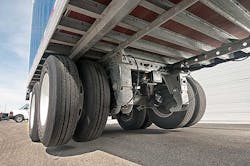SAF-Holland’s Auto-PosiLift axle lift providing efficiency, fuel savings on 300 trailers in PepsiCo’s North America Beverages fleet
OVER the summer, PepsiCo North America Beverages gave SAF-Holland a Supplier of the Year award.
That was largely due to SAF-Holland’s Auto-PosiLift axle lift technology on SAF CBX40 Tandem Axle Slider Suspension systems, which have been installed on 300 PepsiCo North America Beverages dry-van trailers built by Great Dane and Hyundai since the spring.
The Auto-PosiLift combines CBX PosiLift components and a Meritor WABCO ABS with lift axle control. A sensor in the system’s air spring supply line reads air spring pressure and determines whether to automatically raise the front axle or leave it in the down position. This arrangement blends the brain and the brawn to increase fleet efficiency.
The CBX40 with Auto-PosiLift was initially developed for multi-stop beverage distribution fleets. Other varying load fleet operations such as LTL (Less Than Truck Load), fleets back hauling empty, and food service may also reap the benefits of fuel savings, reduced tire wear, and reduced toll charges.
The combination of the CBX PosiLift axle lift feature with the ECU and air valve system creates a lift axle with automatic operation that complies with DOT regulations. The system is programmed to read the air pressure in the rear axle air springs each time a delivery or pick-up is made. Without driver interaction, the system determines to automatically raise the front axle or keep the front axle in the down position.
For example, throughout the course of daily deliveries, a company’s load eventually diminishes to a point where the total weight capacity of a closed tandem axle suspension is no longer required to carry the load, thus allowing the front axle of the tandem suspension to be raised. The opposite is also true. Think of an LTL carrier making pick-ups through the day with his front axle up. At some point, the trailer will get enough payload to warrant leaving the axle down for the balance of the trip. Operating with the tandem suspension with the front axle raised increases fuel efficiency, vehicle tire life, suspension component life, and brake/wheel-end service intervals.
“Pepsi loads out in morning heavy, and gets to the first stop and unloads,” says Randy Flanagan, SAF-Holland’s director of sales and marketing-Americas for the trailer systems business unit. “Our system is unique in that it’s set up so that when the trailer brakes are pulled and/or the truck is turned off, both axles are always on the ground. When you start the truck and/or release the brakes, a sensor system determines air pressure, and if enough load has come off the trailer, the front axle will automatically come off the ground to provide four inches of ground clearance. That takes it out of driver’s hands to have to try to figure out when the axle should be lifted, because they could get it wrong, and if they lift it early, they could be too heavy on the down axle, resulting in damage and/or even overweight infractions.
“Another benefit of the system is less drag. You’re not pulling two axles down the road. You’re pulling one, so you’re getting increased fuel economy. You’re not wearing tires out by scrubbing them around corners. Additionally, the wheel ends obviously are not spinning around, so they too last longer. And in some cases, fleets are paying lower toll amounts as well. We have put Auto-PosiLifts on container chassis on the East Coast. Their biggest reason for specifying our product was the reduction in tolls. They only have to pay for the axles on the ground.
“There have been lift axles in the marketplace for years, but this automatic feature is new, along with the fail-safe when the brakes are set or there’s no power to the trailer. We always want this to happen because if you are loading, you want both axles on the ground. If the trailer is empty and you started to load it, you could be loading the trailer with only one axle on the ground. This would result in an overload situation until the system was able to cycle itself again.
“Additionally, for repositioning of the slider, we always want both axles on the ground. And this logic was built into our system so that there wouldn’t be an opportunity for the axle to come down on someone standing near the trailer while loading. “
PepsiCo North America Beverages fleet manager Roland Bailey said that the company has had good success with the 300 trailers that feature the Auto-PosiLift axle lift.
“The driver acceptance has been extremely positive, since most drivers report not knowing the difference between when the axle is lifted and when it is down,” he said. “Like any new product, we have made a few adjustments to the programming and added some additional features that were not part of the initial prototype.
“The lift axle is a new tool in our arsenal of improving fuel economy, reduction in brake, tire and axle wear. There are also soft benefits like toll reductions and lack of driver intervention, so we know that the system delivers the benefits as soon as we reach the threshold of bridge and weight regulations.”
Bailey said PepsiCo has seen an average reduction in the forward axle wheel revolutions of 60% to 80% and that, in general terms, the cost of wheel-end maintenance on the lifted axle should be reduced by approximately the same amount. ♦
About the Author
Rick Weber
Associate Editor
Rick Weber has been an associate editor for Trailer/Body Builders since February 2000. A national award-winning sportswriter, he covered the Miami Dolphins for the Fort Myers News-Press following service with publications in California and Australia. He is a graduate of Penn State University.
